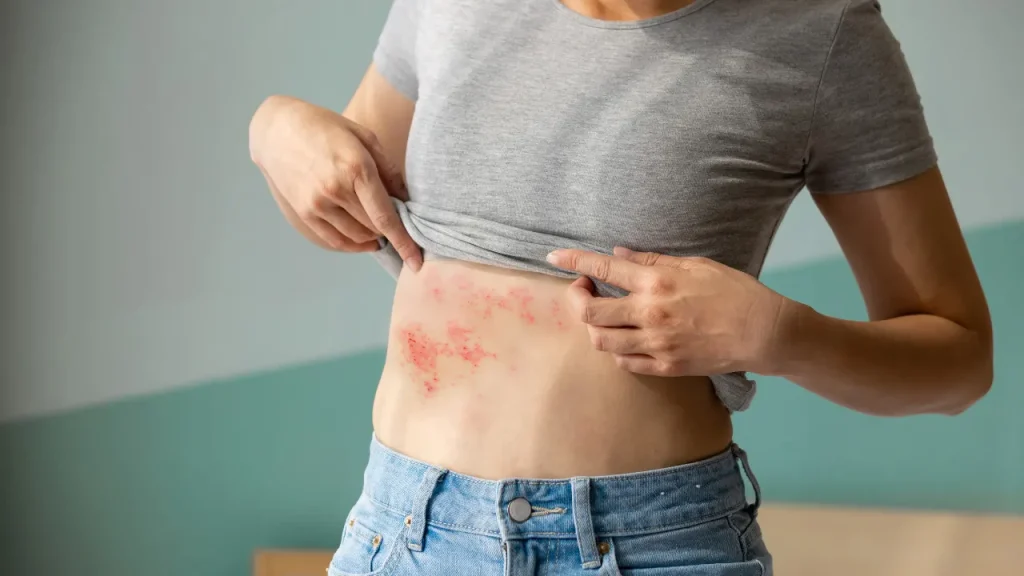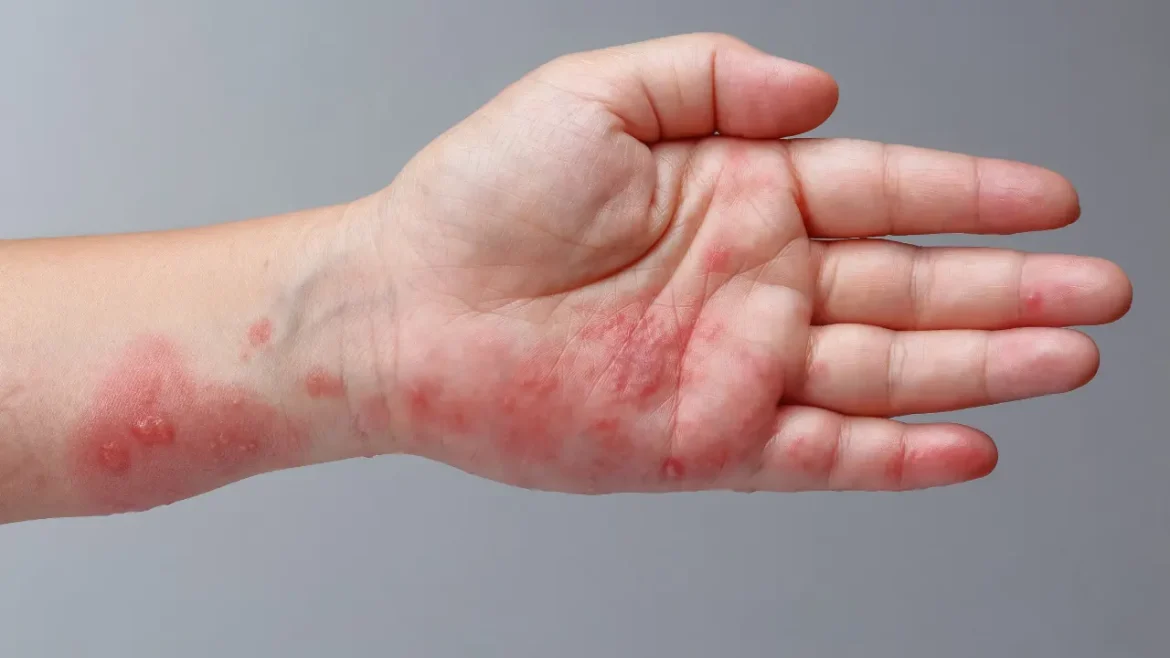Description
The skin being infested with Sarcoptes scabiei mites results in scabies. It causes an itchy and infectious skin rash and spreads through close physical contact. Small red blisters, lumps, and tracks on one’s skin are the hallmarks of the irritating rash caused by scabies. When the mite penetrates into the epidermis by laying eggs, an inflammatory reaction occurs. The main signs are severe itching, particularly at night, and the development of linear skin burrows which are frequently seen in the web gaps between the wrists, fingers, elbows, buttocks, and genitals.
You May Also Like:
5 GREAT REASONS TO TRY APIGENIN FOR STRESS RELIEF
5 GREAT WAYS TO REDUCE STRESS AND ELEVATE MOOD WITHOUT ALCOHOL
Scabies: Description, Causes, And Treatment Protocol is an original (HealthXWire) article.
Possible Causes
The Sarcoptes scabiei mites may thrive for as long as 72 hours without a human host. The mites are mainly spread via prolonged contact between people’s skin, like sexual intercourse, or by sharing contaminated clothes or bedding. Infestation and transmission risks might be increased by crowded living situations, poor cleanliness, and weakened immune systems.
Exacerbating and Mitigating Factors
Exacerbating Factors: –
Compromised Immune System: Scabies infestations are more likely to occur in those who have compromised immune systems, including those having organ transplant recipients, HIV/AIDS, or anyone taking immunosuppressive medicine. Effective mite management and eradication may be challenging due to compromised immune responses.
Close Contact: Scabies is extremely contagious and spread via extended skin-to-skin interaction with an infected person. The possibility of transmission is increased by close contact activities including sharing bedding, sexual contact, or residing in close quarters.
Delayed Detection and Care: Scabies symptoms can worsen and the infestation may spread further if diagnosis and treatment are delayed. If people feel they have scabies, they should consult a doctor immediately to avoid complications and spread.
Inadequate Care or Noncompliance: Taking scabicidal drugs insufficiently or improperly can result in treatment failure and scabies recurrence. The elimination of the mites may also be hindered by noncompliance with the specified treatment schedule, like not using the medicine for the necessary amount of time or skipping doses.
Mitigating Factors: –
Simultaneous Treatment of Infected People and Close Contacts: To stop reinfestation and the cycle of spread, it is crucial to treat all infected people at once, along with their close connections. All those who have come into extended, close association with the infected person must be identified and treated.
Good Hygiene Practices: Good hygiene practices, including routine handwashing, maintaining a tidy living space, and washing infected bedding and clothing using hot water will help stop the transmission of scabies. Mite removal may also be aided by carefully cleaning and vacuuming rugs and upholstered furniture.
Education and Awareness: By increasing understanding of scabies and its transmission, people can identify the signs early on and seek urgent medical assistance immediately. Effective prevention and management might increase from education on appropriate treatment regimens and hygiene measures.
Environmental Measures: By maintaining clean conditions for living, precautions can be taken to lower the likelihood of re-infestation. Vacuuming, cleaning, and washing surfaces that might have gotten into touch with the mites may be required, along with sanitizing clothing, bedding, and personal things.
Monitoring and Compliance: Successful scabies management depends on keeping in touch with medical experts and following the recommended treatment plan. It is crucial to finish the entire medication course and to consult a doctor if symptoms worsen or return.

Standard Treatment Protocol
Using scabicidal drugs to get rid of the mites alongside their eggs is the traditional course of action for treating scabies. The main forms of treatment include: –
Ivermectin: Oral ivermectin can be recommended for resistant or severe scabies. A second dose of this drug may be necessary between one and two weeks following the initial one. Ivermectin causes the mites’ neurological system to malfunction, which kills them. Ivermectin must not be used on pregnant women or kids who weigh less than 15 kg.
Crotamiton, Lindane, and Sulfur Ointment: Alternative therapies for scabies are sometimes employed when more traditional ones fail to work or are ineffective for a particular patient. Lindane is not recommended for use in newborns, pregnant women, young children, or those who have specific medical problems because of its potential neurotoxicity.
Permethrin: The first-line therapy for scabies is a topical medication called permethrin. From the neck region down, it is used on the whole body surface, and after a period between 8 and 14 hours, it is washed off. Even for babies and expectant mothers, permethrin is typically safe and efficient.


Treatment Options
Antibiotics: If individuals scratch the scabies rash, they could have secondary bacterial infections. For treating bacterial infections in such circumstances, antibiotics may be provided. To choose the right antibiotic and the length of the therapy, it is essential to speak with a medical expert.
Antihistamines: Scabies-related itching can be reduced with the help of antihistamines like diphenhydramine or cetirizine. They function by preventing histamine, which causes the itching, from being released. When the scabicidal treatment is working, over-the-counter antihistamines can offer momentary comfort.
Moisturizers: To relieve the dry, irritated skin brought on by scabies, moisturizers or emollients can be applied to the affected regions. For the purpose of preventing further discomfort, moisturizers should be mild in nature and non-scented.
Over-the-Counter Formulations: Certain over-the-counter medications might ease scabies symptoms, but they might not get rid of the mites. Identical to prescription-strength drugs, these products frequently contain pyrethrins or permethrin. To ensure over-the-counter remedies are suitable for treating scabies, it is imperative to speak with a healthcare provider before using them.
Nutritional Supplements: Although there is little scientific data addressing the usage of dietary supplements for curing scabies, preserving general skin health and bolstering the immune system via a balanced diet may prove advantageous. The following dietary supplements may be useful in the treatment of scabies: –
- Vitamin A
Maintaining good skin and boosting the immune system are both greatly helped by vitamin A. It aids in preventing skin infections while promoting the growth and regeneration of skin cells. Sweet potatoes, carrots, liver, and spinach are examples of food sources of vitamin A.
- Vitamin C
Antioxidant vitamin C helps to produce collagen, which is necessary for healthy skin and supports immunological function. It supports wound healing and strengthens the skin’s natural defenses. Citrus fruits, bell peppers, strawberries, and broccoli are excellent vitamin C sources.
- Omega-3 Fatty Acids
Besides supporting general skin health, omega-3 fatty acids contain anti-inflammatory qualities. They may be able to lessen the swelling brought on by several skin problems, including scabies. Fatty fish like salmon, sardines, and mackerel, along with flaxseeds, walnuts, and chia seeds are excellent suppliers concerning omega-3 fatty acids.
- Zinc
Zinc contains anti-inflammatory effects and is involved in immunological function. It maintains skin health and encourages wound healing. Foods including oysters, poultry, meat, nuts, and seeds incorporate zinc.
Nevertheless, the principal scabicidal drugs that a healthcare provider has given should not be replaced by nutritional supplements.
Natural and Herbal Remedies: As supplemental medicines in the treatment of scabies, natural and herbal treatments are frequently employed. Following are a few natural and herbal cures that are frequently recommended: –
- Neem Oil
Neem oil holds a long history of usage in Ayurvedic medicine due to its antibacterial qualities. It might aid in mite eradication and symptom relief. After dilution with carrier oils, neem oil may be used topically on the afflicted areas. Neem oil can irritate some people’s skin and possesses a potent odor, making it vital to be aware of that.
- Tea Tree Oil
Antibacterial and anti-inflammatory effects can be found in tea tree oil. It may help reduce itching and inflammation associated with scabies. Diluted tea tree oil can be applied topically to the affected areas after patch testing on a small area of skin to check for any adverse reactions.
- Clove Oil
Since clove oil possesses analgesic and antibacterial qualities, it may temporarily reduce irritation. When administered topically to the afflicted areas, it must be diluted using carrier oils. Clove oil ought not to be applied undiluted because it could irritate certain people’s skin.
- Aloe Vera
The calming and anti-inflammatory qualities of aloe vera may aid to lessen irritation and encourage healing. To relieve symptoms, aloe vera gel derived from the leaves may be administered topically to the regions affected. Individuals should apply only natural aloe vera gel with no additional components that could irritate their skin.
- Turmeric
Curcumin, a compound found in turmeric, possesses antimicrobial qualities. It might lessen scabies-related itchiness and swelling. Turmeric can be ground into a paste for its topical application on the affected regions by combining it with carrier oils or water.
However, it is important to keep in mind that these herbal and natural treatments may not totally get rid of the mites and that each person may respond differently to them. They ought to be taken as supplemental therapies in addition to the typical scabies treatments that a healthcare provider has recommended.


Conclusion
Scabies is a contagious skin infestation caused by the microscopic mite Sarcoptes scabiei. The hallmarks of scabies are small red bumps that track on the affected skin. It can be both a physically discomforting and socially stigmatizing condition. The mites first manifest as an itchy rash and burrows in the skin. It typically targets areas like the hands, wrists, and between the fingers.
Prompt recognition and treatment are essential for managing and containing the spread of scabies. For instance, oral ivermectin, crotamiton, and permethrin target the mites, providing relief from the itch. However, all are not safe for expectant mothers except for permethrin. To prevent re-infestation, good personal hygiene, nutritional supplements, and a consistent care routine are essential. By following this, individuals can find themselves successfully rid of scabies and regain comfort.


Additional resources for further reference
https://www.mayoclinic.org/diseases-conditions/scabies/symptoms-causes/syc-20377378
https://my.clevelandclinic.org/health/diseases/4567-scabies
https://pubmed.ncbi.nlm.nih.gov/32484302/
Important Note: The information contained in this article is for general informational purposes only, and should not be construed as health or medical advice, nor is it intended to diagnose, prevent, treat, or cure any disease or health condition. Before embarking on any diet, fitness regimen, or program of nutritional supplementation, it is advisable to consult your healthcare professional in order to determine its safety and probable efficacy in terms of your individual state of health.
Regarding Nutritional Supplements Or Other Non-Prescription Health Products: If any nutritional supplements or other non-prescription health products are mentioned in the foregoing article, any claims or statements made about them have not been evaluated by the U.S. Food and Drug Administration, and such nutritional supplements or other health products are not intended to diagnose, treat, cure, or prevent any disease.
Table of Contents


